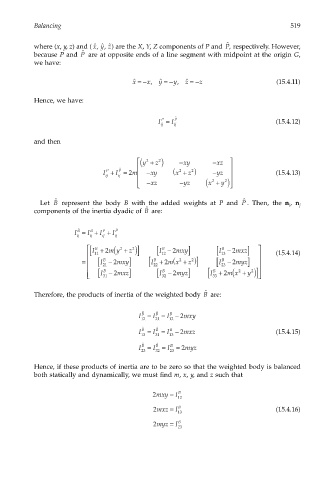Page 538 - Dynamics of Mechanical Systems
P. 538
0593_C15_fm Page 519 Tuesday, May 7, 2002 7:05 AM
Balancing 519
where (x, y, z) and ( ˆ, ˆ, ˆ ) are the X, Y, Z components of P and ,P ˆ respectively. However,
xyz
ˆ
P
because P and are at opposite ends of a line segment with midpoint at the origin G,
we have:
ˆ x =− , x ˆ y =− , y ˆ z =− z (15.4.11)
Hence, we have:
I = I P ˆ (15.4.12)
P
ij ij
and then
( y + ) − xy − xz
2
2
z
P ˆ
I + I = 2 m − xy ( x + ) − yz (15.4.13)
P
2
2
z
ij ij
− − ( x + )
2
2
xz yz y
Let B ˆ represent the body B with the added weights at P and P ˆ . Then, the n , n j
i
ˆ
B
components of the inertia dyadic of are:
B ˆ
I = I + I + I P ˆ
B
P
ij ij ij ij
m y + )]
I + ( 2 z 2 I − 2 mxy] I − 2 mxz]
B
B
B
2
[ 11 [ 12 [ 13 (15.4.14)
z ]
(
= I − 2 mxy] I + 2 m x + ) I − 2 myz]
B
B
2
2
B
[ 21 mxz] [ 22 myz] I + (
[ 23
B
2
B
2
B
y
I − 2
[ 31 [ 32 [ 33 2 m x + )]
I − 2
ˆ
Therefore, the products of inertia of the weighted body are:
B
B ˆ
B ˆ
I = I = I − 2 mxy
B
12 21 12
B ˆ
B ˆ
I = I = I − 2 mxz (15.4.15)
B
13 31 13
B ˆ
I = I = I = 2 myz
B ˆ
B
23 32 23
Hence, if these products of inertia are to be zero so that the weighted body is balanced
both statically and dynamically, we must find m, x, y, and z such that
2mxy = I B
12
2mxz = I B (15.4.16)
13
2myz = I B
23

